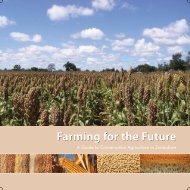Restoring the Soil - Canadian Foodgrains Bank
Restoring the Soil - Canadian Foodgrains Bank
Restoring the Soil - Canadian Foodgrains Bank
You also want an ePaper? Increase the reach of your titles
YUMPU automatically turns print PDFs into web optimized ePapers that Google loves.
52Decision Tree Guidenot dry-season rotations. These systemsviolate <strong>the</strong> gm/cc rule of not spendingmoney or effort on transportation, butthousands of farmers use this system inBurkina Faso. These systems do usuallyrequire a lot less labor than collecting andtaking animal manure out to <strong>the</strong> fieldsfrom <strong>the</strong> homestead.28. Thailand. Lablab beans, cowpeas and ricebeans are each grown during <strong>the</strong> dry season inmaize fields in nor<strong>the</strong>rn Thailand. The practice wasoriginally developed by <strong>the</strong> farmers mostly to keepdown <strong>the</strong> weeds and maintain soil moisture, but<strong>the</strong>se gm/ccs now are also being consumed andsold in <strong>the</strong> local market.rejected by farmers.45. Hedgerows. These are not usuallyvery popular among farmers because <strong>the</strong>yoccupy land that farmers’ crops couldbe using and because <strong>the</strong>y often requirepruning during <strong>the</strong> wet season, when <strong>the</strong>demand for labor is highest. This is why“alley cropping” was almost universallySeveral things can be done to make hedgerows less objectionable. First, farmersshould be consulted about <strong>the</strong> distance between hedgerows. If <strong>the</strong>y choose (as<strong>the</strong>y likely will) a distance such as 25 m between hedgerows, we should agree eventhough <strong>the</strong> impact on soil fertility will be minimal due to this large distance. Intime, when <strong>the</strong>y see <strong>the</strong> impact of <strong>the</strong> hedgerows on soil fertility, <strong>the</strong>y may wantto add a hedgerow between each of <strong>the</strong> two <strong>the</strong>y already have, making <strong>the</strong> distance12 m instead of 25 m. Perhaps a better practice would be to add a secondrow of bushes to <strong>the</strong> already existing headgerows.Second, if dispersed trees are planted in <strong>the</strong> hedgerows, <strong>the</strong> hedgerows will be lessobjectionable, because <strong>the</strong>y will be occupying <strong>the</strong> area of maximum shade, wherecrop growth may be somewhat poor anyway if <strong>the</strong> pruning is not done heavilyenough. Fur<strong>the</strong>rmore, <strong>the</strong> hedgerows will be seen as part of a total system withbenefits of moisture retention and crop shade in addition to soil fertility.Third, if on hillsides <strong>the</strong> hedgerows can double as contour hedgerows to preventerosion, <strong>the</strong>y will be more acceptable. This is <strong>the</strong> case on several islands in Indonesia,where <strong>the</strong> alley cropping hedgerows have met with considerable acceptance.Fourth, some hedgerow species, such as nyama (Piliostigma reticulatum), canbe pruned to ground level, which gives <strong>the</strong> field crops a head start. Nyama isa native bush in much of <strong>the</strong> Sahel, from Senegal to Kenya. It is a perennialwhose leaves do an extremely good job of fertilizing <strong>the</strong> soil. It is very resistant toanimals (although some protection may be required <strong>the</strong> first year) and maintainsits leaves until June, when <strong>the</strong> rains come. A field that is no longer fertile can beplowed and nyama seedlings planted, ei<strong>the</strong>r from a nursery or using seedlingsthat volunteer near where <strong>the</strong> bushes already exist. The seeding rate will dependon <strong>the</strong> number of seedlings available, but <strong>the</strong>y could be planted one seedling
















